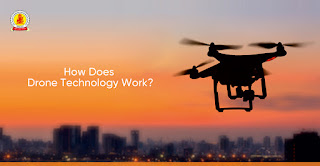What is Drone Technology? - How Its Work
With the advent of time, UAV drone technology is evolving as new innovation and big investment are bringing more advanced drones to the market every few months. There are the most popular drones on the market, which have all the latest drone technology. Most UAV drones will have very similar systems incorporated into it.
Unmanned aerial vehicle technology covers everything, ranges from the aerodynamics of the drone, materials in the manufacture of the physical UAV, to the circuit boards, chipset and software. They are considered as the brains of the drone. One of the most popular drones on the market is known as DJI Phantom series. These drones are quite popular with professional aerial cinematographers. This Phantom UAVs are ideal to explain drone technology, as it offers everything in one package. It includes the UAV, gimbal and camera. Moreover, the top engineering colleges in Jaipur have some of the top drone technology on the market today.
In earlier days, more new and highly advanced drones like DJI Mavic Mini, Mavic Air 2, Phantom 4 Pro V2.0, Mavic 2, Yuneec Typhoon H3 and Autel Evo 2 have come to the market. The fast pace of UAV drone technological innovation is tremendous.
How Do Drones Work?
The drones or unmanned aerial vehicles (UAVs) are an aircraft system without a flight crew onboard. As such, drones can range in size from large military drones to smaller drones, like the DJI Mavic Pro 2, that you might see while using a film video or inspect a property. The defining trait of a UAV is that it is unnamed. Drones come in two main types including fixed-wing and rotary.
Fixed-wing platforms are exactly as they sound. In other words, the wings are fixed to the fuselage (body of the aircraft). For instance, the Boeing 737 is a fixed-wing commercial jet. In this, the wings are attached to the fuselage and they cannot move. On a fixed-wing platform, the aircraft flies forward to push the wings through the air to generate lift.
Rotary platform configurations are very different from fixed-wing platform configurations. A rotary platform has a rotary-wing (i.e., a propeller) that is fixed to a motor. On a rotary platform, the motor spins the rotary wing against the air to create lift. One of the most common types of rotary drones is called a quadcopter. A quadcopter, like the Mavic Pro 2 we referred to before, has four motors and four propellers.
How Do Drones Fly?
Because quadcopters are so popular, Best Engineering College in Jaipur has used it as the primary example to explain how drones fly. When a quadcopter flies, the motors spin the propellers and the propellers PUSH against the air molecules to move the drone. As the propellers spin, they push the air molecules downward, which pulls the drone upwards. Once the drone is flying, it is able to move forward, back, left, and right by spinning each of the 4 propellers at a different speed.
Drones are flown using a flight controller. In other words, the flight controller is the “brains” of the drone. It takes in information sent to it by the remote controller, GPS, obstacle avoidance sensors, and other components and then sends signals to the motors to properly respond to the information.
For instance, if students of engineering colleges were flying a drone and pushed forward on the control stick, they would be sending a signal to the flight controller to move the drone forward. If this were a GPS drone (in GPS mode), you would effectively be telling the flight computer to move the drone to a GPS location further in front of where it is now. The flight controller would check with the GPS to gather information, then fire up the rear motors (if on a quadcopter) to move the drone in a forward direction.
A detailed description to Drone Technology
Although the remote pilot is responsible for flying the drone, many drones come with built-in technology to make flying easier. One of the main features of commercial drones today is obstacle avoidance. Using a series of sensors that allow the drone to detect obstacles in multiple directions, the drone will alert the pilot that there is an obstacle in the way of the flight path. If the pilot flies the drone too close to the obstacle, the drone will typically stop and hover in place until the pilot directs the drone around or away from the obstacle. If the battery power level gets too low the drone will also utilize the sensors to find a safe place to land.
Students of Best BTech Colleges in Jaipur should know that the Drone technology is not just flight-related, many drones are outfitted with special equipment to conduct a particular task. For instance, drones used in video and photography not only possess high-end cameras, but they also have special devices called “gimbals” that help hold the camera in place while the drone moves in various directions. With the help of the gimbal, pilots can take smooth aerial shots that you may see in commercials or films.
Conclusion
Although drones easier to fly than ever before, it is still important for the students of best engineering colleges to understand how drones work and the specific types of drone technology your drone utilizes so that you can make the most of each flight.
Also, you can gain more knowledge about drones with the faculties of Arya College. We have also integrated this topic in the advanced curriculum. Our course will help you really dive into the world of drones.


Comments
Post a Comment